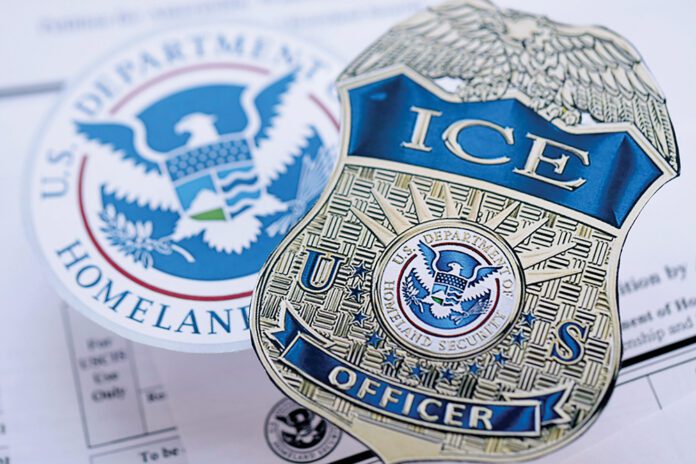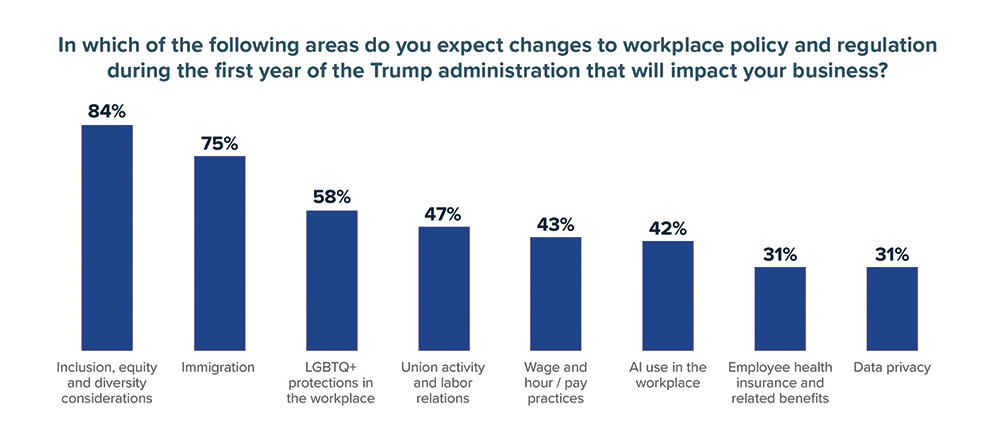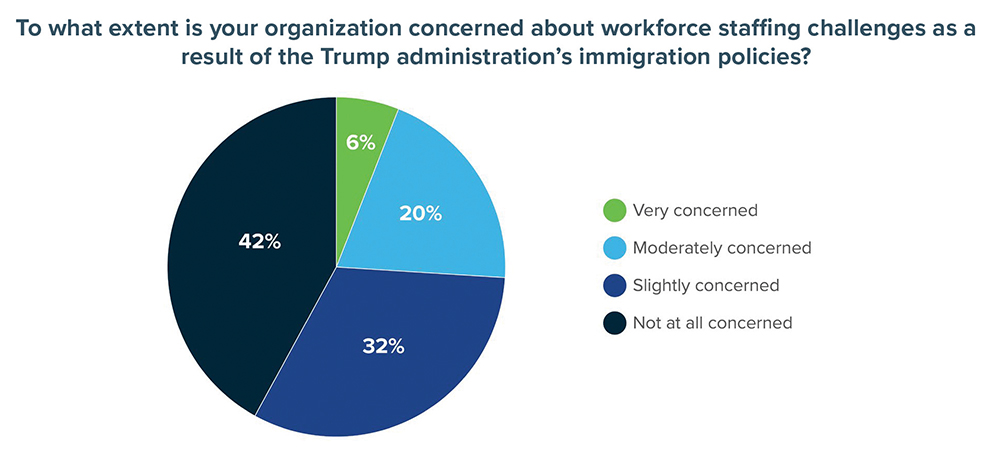
In the wake of increased enforcement activity, employers should make a plan in case they are visited by U.S. Immigration and Customs Enforcement (ICE) agents.
ICE visits, often referred to within media outlets as “raids,” are essentially enforcement actions by the federal government designed to identify and detain undocumented employees, usually toward specific individuals. ICE agents can arrive at worksites without warning as part of an employer investigation.
It should be noted that ICE agents are not police officers. But their uniforms may say “police” or “federal agent.” They may carry guns. Occasionally they will arrange to appear with local police officers for additional support.
Employers are increasingly being targeted as a location for ICE raids for undocumented immigrants. Those raids increased since the start of President Donald Trump’s second administration earlier this year, according to Julianne Cassin Sharp, a principal and leader of the immigration practice team at law firm Miller Canfield in Detroit.
She says there has always been a focus to find undocumented immigrants with past administrations, but the focus of the raids have evolved.
Additionally, ICE agents under the Trump administration are requiring less documentation during these unexpected visits, based on subjective feedback Miller Canfield is receiving from clients and numerous media reports.
One of the most important things for employers to know if immigration and customs enforcement agents visit one or more locations is that they should ask to see a judicial warrant that includes a valid signature. If the agents can’t provide that, or are only able to provide an agency warrant, ICE may need to get a judicial warrant before conducting a legal search of a workplace.
“(A request for) inspection documents may not be enough,” Cassin Sharp says. “The biggest thing to keep in mind is that with the right warrant, you will have to respond to the ICE agents.”
The 13th Annual Employer Survey released earlier this year by Littler, a global employment and labor law practice representing management professionals, indicates that most U.S.-based employers (84%) say that changes to workplace regulations and policies surrounding inclusion, equity and diversity (IE&D) will impact their businesses during the first year of the Trump administration. The second most prominent trend to impact are changes related to immigration policy at 75 percent, the survey results reveal.

On the immigration front, 58% of employers are concerned about potential staffing challenges resulting from the Trump administration’s immigration policies. Nearly three-quarters (70%) expect enforcement by ICE/Homeland Security Investigations and the Department of Homeland Security to have a significant or moderate impact on their workplaces over the next 12 months.
The survey draws on insights from nearly 350 in-house lawyers, business executives and human resources professionals.
“With the expected uptick in worksite enforcement, it is important for employers to proactively conduct reviews to check that I-9 forms are up to date, that they know where they’re located, and that there is a crisis management team in place in the event of a site visit from ICE or another government agency,” Jorge R. Lopez, Littler shareholder and chair of the firm’s Immigration and Global Mobility Practice Group, said in a statement.
“At the same time, businesses should be cognizant of changing policies on legal immigration and the resulting challenges to maintaining a steady workforce to meet business objectives,” Lopez adds.
The importance of documentation
Employers may also be asked for payroll records, or I-9 documents, during an ICE visit, said Cassin Sharp. Based on media reports, ICE agents under the Trump administration seem to be targeting employers in industries where there is the likelihood of more undocumented immigrants present, including such sectors as construction, food and cleaning services. They may also target employers where they have a strong lead that one or more undocumented aliens is present.
While more attention is being given to these types of actions since January, ICE raids over the past decade have often featured agents targeting employers – no matter which political party occupied the White House.

“The thought is that they can find more undocumented aliens in these types of industries,” Cassin Sharp says. “They know where to look even if they don’t have a specific person in mind.”
I-9 and other employee documentation is where many small and mid-sized businesses fall short, according to Sherri McDaniel, CEO of the Livonia, Mich-based human resources firm Sage Solutions Group.
“You need an HR function on top of I-9 documents,” McDaniel says. “ICE can request to see those documents and as an employer you need to know where they are, and if they have recently been reviewed or audited.” McDaniel estimates that more than 50 percent of its clients and prospects do not have a good handle on their I-9s.
“It seems like a simple task but there’s much more to handling (I-9 and other relevant) documentation,” she adds. “It can be incredibly costly if you make mistakes.”
For example, ICE issued a notice of intent in late April to fine three Denver-area businesses over $8 million following worksite audits that uncovered widespread employment eligibility violations. The majority of those fines were assessed to CCS Facility Services, a commercial janitorial and maintenance services provider, which was fined nearly $6.2 million after a 100% substantive violation rate and what ICE says was evidence of knowingly hiring and employing at least 87 unauthorized workers.
In fact, employers can choose from three different I-9 forms that are available online at the U.S. Citizen and Immigration Services website. These forms have been edited multiple times over the past few years, so organizations should never take a shortcut with them, McDaniel said.


Colleges are a target
Institutions of higher learning have also been a target of ICE raids because of the potential for undocumented students and instructors. All colleges and universities should also be prepared for a possible ICE intrusion, says Cassin Sharp, a process that includes the process of educating constituents, including students.
Colleges and universities are not required to check the residency status of students for them to attend their institution, but that doesn’t prevent investigations and deportations. That makes these schools a huge mark for raids.
“These (colleges) should find an effective way of communicating and informing students, faculty and even (custodial) and other blue-collar staff,” Cassin Sharp says. “Know your rights as (an individual) and your requirements (as an institution).”
Develop a sensible response plan
Employers that are more likely to be targeted by ICE raids should have a plan in place if it happens, Cassin Sharp says. That plan should identify one or more key point persons at the organization, often a legal employee or member of the internal general counsel team. Third-party counsel can also be an effective partner, especially if they are available to respond immediately.

Cassin Sharp recommends that the leadership team at an organization should develop and communicate the plan to employees, even if they do not feel a raid is likely, or if they are confident that they don’t have undocumented aliens on the payroll. The frontline person who would be the first to react to an ICE visit (often a receptionist) should know who to connect and what the process is.
Anyone responding to an ICE visit, and all organization leaders, should be educated about internal policies, administrational issues, and what to ask of the agents.
“You can’t be too careful,” Cassin Sharp says. “When responding you don’t want to appear intimidating or aggressive towards the agents. Your plan shouldn’t be complicated either. Have the chain of command set up and you’ll be able to put everyone who works there at ease.”
That response should remain professional as well. Cassin Sharp adds that employers need to be careful not to display any hint of obstruction, whether perceived to be intentional or not. McDaniel agrees.
“The last thing you want to do is get an ICE agent angry or irritated based on your response,” McDaniel says. “They will respond to that approach unfavorably. You want to be helpful but in control of as much of the situation as you can be.”
The preparation for a possible response by immigration agents should be handled in the same way that a fire or tornado evacuation plan is, McDaniel says. Organizations should counsel their internal or external legal team to understand the law and realistic expectations, she adds.

The important role of HR
It’s important to note that an ICE raid generally includes multiple immigration agents who are wearing tactical gear. That scene alone can be intimidating and demoralizing to any professional, especially if they are not prepared for it. The stress alone caused by such a scene can result in mental illness challenges that can adversely affect employers for long periods of time, occasionally causing the need for personal leaves.
“Many of us spend a lot of time at work, and often about as much time with (colleagues) as do with our families,” McDaniels says. “It can hard to (anticipate) a road, so you need to train your frontline staff and let other employees know about the plan in advance.”
That’s where a human resource department or third-party consultant can help. Above all, an HR team exists to create a safe and helpful environment for all employees, McDaniel says. Privately-owned organizations or a nonprofit with a small internal or outsourced staff should create a process that is reviewed and approved by the leadership team and legal experts.
A response plan can also include the use of a public relations firm or external expert to help provide communications that are designed to protect the company’s brand to its clients, customers, suppliers and the public at large.
Consequences can be significant
Without documentation transparency detailing employee information, an employer may be faced with a costly and time-consuming I-9 audit at a later date, or other payroll tax complications. ICE has been known to contact the IRS or other federal agencies about violations.
An I-9 form is required for all new employees. Those forms must be kept on file for three years after hiring or one year following an employee’s last day or work, whichever is later, according to the National Immigration Law Center. The center also recommends that an employer not ask a worker to fill out Form I-9 more than once unless their work permit is about to expire or they employer has another valid, legal reason.
“It comes down to whether there is a pattern or practice of (legal issues),” Cassin Sharp says. The penalties for employers could be monetary or criminal liability in more severe cases.
An I-9 audit leads to a notice of inspection, or a compliance letter that should explain why agents have come.
Despite the recent attention given to these immigrations and customs enforcement activities, the actions of ICE agents are generally designed to only enforce deportations, McDaniel says. The administration of former President Joe Biden took steps to open borders to immigrants from around the world, including places like Ukraine, which have allowed some immigrants to make significant in-roads toward U.S. citizenship, she adds.
Many immigrants have been granted the ability to work in the U.S. in 2025, even if they do not have a Social Security number.
“The whole immigration issue is one we see many family-owned businesses aren’t prepare for or familiar with,” McDaniel says. “We understand that it’s complicated. There’s a lot of routes that organization can take but regardless, they should know the ramifications.”





